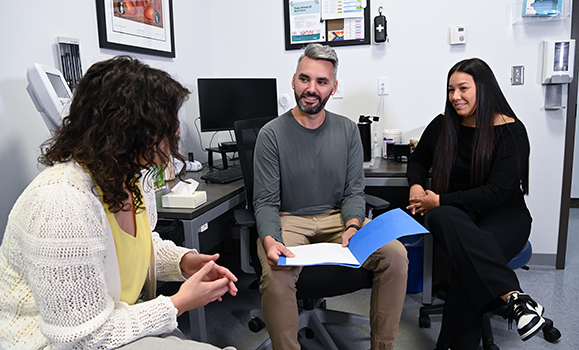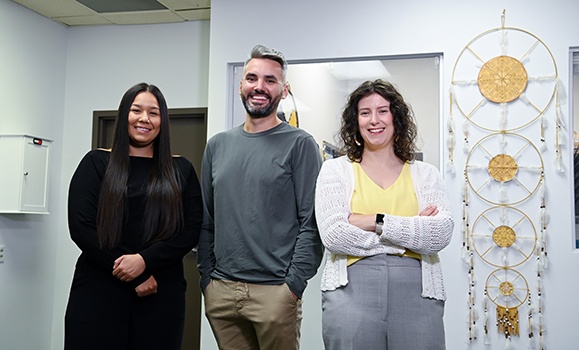Fourth-year medical student Jordin Fletcher hadn’t met a practicing Indigenous physician until she encountered Dr. Brent Young in 2021 when she began medical school as an Indigenous learner.
She had been working as a nurse for five years.
Dr. Shanté Blackmore, a recent family medicine graduate who grew up in Millbrook First Nation, hadn’t worked with an Indigenous preceptor — an experienced practitioner who provides supervision during clinical practice — her entire medical training.
In the spring, this all changed.Ěý
For the first time, they found themselves working side-by-side with an Indigenous staff physician.
Dr. Young, who is Anishinaabe and a member of Sandy Bay First Nation and clinical lead at Wije’winen Health Centre and Sipekne’katik Health Centre, says it was a first for him to supervise an Indigenous medical student and resident together and likely the first time this has ever happened in Mi’kma’ki.
“It was a very interesting and fulfilling experience for me,” he says. “The biggest thing I noticed was the shared understanding we already had as Indigenous people in medicine. Being able to sit down with these learners and do more one-on-one mentorship, especially on how we can approach issues like racism in the health-care system, was very valuable for both their learning and mine.”Ěý
Thanks to the hard work of Dr. Young and the Faculty of Medicine, learners have the opportunity to rotate through Wije’winen Health Centre and up to 50 other wrap-around services offered by the Mi'kmaw Native Friendship Centre, which partnered with the Faculty in 2022 to provide primary care services to the urban Indigenous community of Halifax. At the Sipekne’katikĚý Health Centre, which is located in Indian Brook, learners visit from across the province for electives in family medicine, psychiatry, and other health specialties providing care at the clinic.ĚýĚý
Culturally relevant care
Dr. Blackmore, who is Mi’kmaw and African Nova Scotian, plans to stay in Nova Scotia and practice in Indigenous communities. The last two months of her residency were spent at the Wije’winen Health Centre, an elective she chose with the motivation to have a consistent experience with Indigenous patients.
“Growing up on reserve has made me aware of the inequities that Indigenous Peoples face and while I anticipated this work to be challenging, it has been even more rewarding,” says Dr. Blackmore. “I really wanted to get more experience working directly in community. It has been a valuable experience that I otherwise would not have had in my training.”
Both the Wije’winen and Sipekne’katik Health Centres provide multidisciplinary primary care with a focus on services that are anti-racist and culturally relevant. This includes access to traditional medicines, Elders, and cultural programming such as drum-making, dancing, and language classes. This care model addresses barriers in the health-care system, providing longer appointment times tailored to patient needs, particularly for chronic issues previously neglected.
“The key is that the learning and medicine we practice is of high quality,” says Dr. Young. “Our patient population can be hesitant to seek care in hospital settings or with other specialists, so we have to problem-solve in the primary care setting. This provides valuable learning experiences.”
With many patients presenting with histories of trauma, the clinics focus on trauma-informed care. Learners receive guidance on communication and how to approach the apprehensiveness or mistrust they might notice with some patients. With an emphasis on well-rounded primary care, learners also benefit from the experience of point-of-care ultrasound, EKGs, and other minor procedures.

Listening and learning
Jordin Fletcher applied to medical school recognizing the racism, harm, and overall structural violence Indigenous people regularly face in health care. To then be in an environment where work is done to support Indigenous patients and communities, and the opportunity to work with Drs. Young and Blackmore is nothing short of extraordinary.
“It’s a really special space to be welcomed into, and you have to recognize that as an honour and treat it that way,” she says. “There's a lot to learn and a lot of listening.”Ěý
Jordin is a member of the Missanabie Cree First Nation and Mi'kmaw through her grandfather, who is a member of Millbrook First Nation. Her grandmother is a survivor of Shingwauk residential school in in Sault Ste. Marie, Ontario.Ěý Jordin finished her medical school rotation at the Wije’winen and Sipekne’katik Health Centres in June.Ěý
“I had never worked with an Indigenous staff physician before, so it takes some of the work out of it,” says Jordin. “I could focus on my learning because we're at a different baseline with Indigenous experience and health. I don't have to try to explain things to Dr. Young; he knows, so I can just focus on learning.”
Both the Wije’winen and Sipekne’katik Health Centres are embedded in culturally rich Indigenous communities. The teams that practice there develop trust and long-term relationships with more than just the patients accessing care, but with the wider community in which the clinics reside.
"In the health centres, many staff are members of the community, and that is impactful for the relationship between the health centre and community members, I can feel the difference just being in the space,” says Jordin. “When it's truly community-run, it meets the needs of the community and helps shift that power dynamic between physicians and patients.”Ěý
In 2022, HÂţ» Medical School announced theĚýIndigenous Admissions PathwayĚýto address the barriers that have prevented Indigenous applicants from entering medical school at HÂţ». This fall, the second cohort of 12 students will be admitted under this initiative.ĚýĚý
Dr. Brent Young, who in addition to his clinical responsibilities, also serves as academic director of Indigenous health at HÂţ», believes that despite frequent discouragement and negative news in health care, the trajectory is improving with a new generation of Indigenous physicians emerging in the profession.
“If you had asked me in 2015, when I started medical school, if I would see this in less than ten years, I wouldn't have thought so because there weren't many, if any, other Indigenous medical students with me at the time,” he says. “And so, to see that progress from then to now, it speaks to some of the work that's been done and the way that HÂţ» Medical School has been much more open to change and making things b

